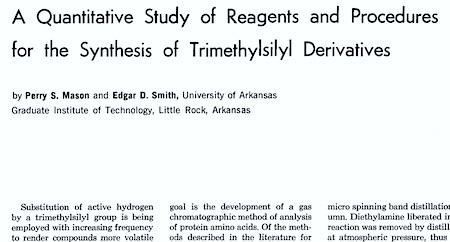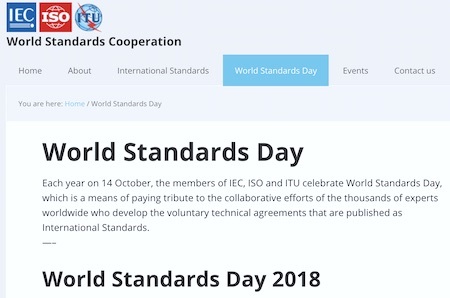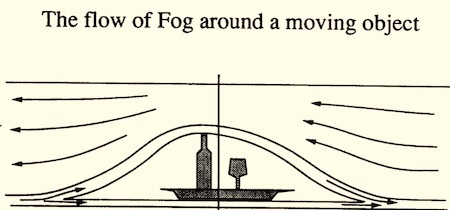Marc Abrahams's Blog, page 161
January 2, 2019
Unwordy Analysis: Can You Identify Authors by Their Punctuation?
Can you identify who wrote a big chunk of text, if you remove all the words and examine only the punctuation. This new study says that in many cases yes, you can:
“Pull Out All the Stops: Textual Analysis Via Punctuation Sequences,” Alexandra N.M. Darmon, Marya Bazzi, Sam D. Howison, and Mason Porter, SocArXiv. January 1. 2019. The authors, at the University of Oxford, the University of Warwick, and University of California, Los Angeles, write:
Whether enjoying the lucid prose of a favorite author or slogging through some other writer’s cumbersome, heavy-set prattle (full of parentheses, em-dashes, compound adjectives, and Oxford commas), readers will notice stylistic signatures not only in word choice and grammar, but also in punctuation itself…. In this paper, we examine punctuation sequences in a corpus of literary documents and ask the following questions: Are the properties of such sequences a distinctive feature of their punctuation sequences? Do the punctuation styles of authors evolve over time? Are we on to something interesting in trying to do stylometry without words, or are we full of sound and fury (signifying nothing)? …
Using a large corpus of documents from Project Gutenberg, we observed that simple punctuation-based quantitative features (which account for both frequency and order) can distinguish accurately between the styles of different authors.
Here are further details from the study.
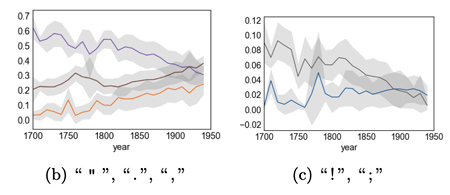
In (a), we show the temporal evolution of all punctuation marks. For clarity, we also separately plot (b) the three punctuation marks with the largest frequencies in the final year of our data set.
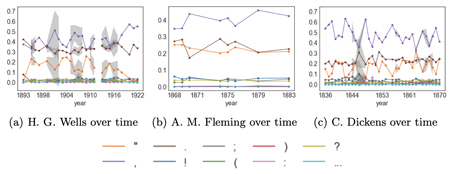
Temporal evolution of mean number of words between two consecutive punctuation marks versus author middle years, which we
bin into ten-year periods starting at 1700. This reflects how the punctuation rate in our corpus has changed over time.

January 1, 2019
Perry Mason and the Selection and Use of Puppets in Counseling
Perry Mason, noted Los Angeles attorney, is the central character in a series of novels, and then movies and radio programs and TV programs, created by Erle Stanley Gardner. Perry Mason—a different and non-fictional Perry Mason—is co-author of a scholarly study on the selection and use of puppets in counseling. Here is the cover of a novel about the more famous, fictional Perry Mason:
The puppet study is: “The Selection and Use of Puppets in Counseling,” Professional School Counseling, Richard B. Carter, and Perry S. Mason, vol. 1, no. 5, 1998, pp. 50-53.
Perry S. Mason, Jr., was a professor of chemistry, from 1969-2008, at Lubbock Christian University, Texas, and was also a minister. If your interests incline toward chemistry, you might also enjoy reading one of Perry S. Mason’s studies that does not involve puppets:
“A Quantitative Study of Reagents and Procedures for the Synthesis of Trimethylsilyl Derivatives,” Perry S. Mason Edgar D. Smith, Journal of Chromatographic Science, vol. 4, no. 11, 1 November 1966, pp. 398–400.
The fictional Perry Mason’s adventures became so popular that people jokingly, and sometimes not so jokingly, worried about “Perry Mason Syndrome“—a supposedly widespread belief that what happened in real courtrooms was as dramatic, as exciting, as sure to have an improbable last-minute twist that produced a happy ending, as what happened in the novels, films, radio and TV programs.
Here’s a thrilling scene in one of the Perry Mason TV episodes. The villain in this episode is played by actor Leonard Nimoy, who later appeared in a TV series about improbable voyages to seek out new life and new civilizations, to boldly go where no man has gone before:
BONUS: A scholarly paper on still a different topic, written by yet another Perry Mason: “Illustrations of the Early Treatment of Depreciation,” Perry Mason, The Accounting Review, vol. 8, no. 3, September, 1933, pp. 209-218.

December 31, 2018
Virtual Reality ‘Teabagging’ – an ‘unlaughing’ matter for hardcore gamers (study)
“
First popularized within Halo 2 multiplayer competitive matches, teabagging is a controversial practice where the player’s avatar repeatedly crouches over a defeated player’s ‘body’ in order to simulate rubbing his or her genitals over the avatar’s body” [our hyperlink]
By way of a recent essay for the academic journal Games and Culture, the first (and quite probably as yet the only) critical scholarship study of Virtual Reality Teabagging is provided by , who a doctoral student at the Department of Communication, University of Massachusetts Amherst, Amherst, MA, US.
He informs that some ‘hardcore’ First Person Shooter (FPS) enthusiasts are often not amused by such practices – quoting a comment from a player :
“I think teabagging represents a lower level of FPS play. Time spent teabagging a player could otherwise be used to reach the next objective, defend the area, or go on the offense once more. Many times a second or two counts, so the player engaged in teabagging isn’t thinking of the big picture.”
Thus, when confronted with VR teabagging, it’s not uncommon, says the author, for ‘serious’ players to resort to ‘unlaughter’.
“Unlaughter is more than just the absence of laughter but is instead the conscious withholding of laughter in response to an invitation or demand to laugh.”
In conclusion, he adds, however :
“Alongside the derisive sneer or the silence of unlaughter, then, I optimistically assert that perhaps another kind of laughter exists, one that is gentler and more receptive. If nothing else, the example of teabagging demonstrates that those moments of laughter are not beyond the realm of possibility and that allowing for those moments can offer critical inquiry resources for new alliances and reparative practices.”
See: ‘Friends With Benefits : Plausible Optimism and the Practice of Teabagging in Video Games’ which is awaiting publication in a future issue of the journal Games and Culture. (A full copy may be found here courtesy of the University of Massachusetts Amherst.)
Note: For an overview of real-world (as opposed to virtual-world) ‘teabagging’ see John Waters’ 1998 film Pecker.
Also See: Teabagging in the Name of Science
[ Research research by Martin Gardiner ]

December 30, 2018
Whithering commentary about misconduct
Whither, oh why, do some researchers misconduct themselves professionally, and what is to be done about it? This study wants you to wonder about that:
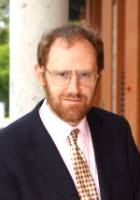 “Whither research integrity? Plagiarism, self-plagiarism and coercive citation in an age of research assessment,” Ben R. Martin, Research Policy, Volume 42, Issue 5, June 2013, Pages 1005-1014. The author laments:
“Whither research integrity? Plagiarism, self-plagiarism and coercive citation in an age of research assessment,” Ben R. Martin, Research Policy, Volume 42, Issue 5, June 2013, Pages 1005-1014. The author laments:
“This extended editorial asks whether peer-review is continuing to operate effectively in policing research misconduct in the academic world. It explores the mounting problems encountered by editors of journals such as Research Policy (RP) in dealing with research misconduct.”

December 29, 2018
When were World Standards Day 2018?
This year, 2018, World Standards Day was celebrated on October 14.
In Canada, World Standards Day was celebrated on October 4.
In the USA, World Standards Day was celebrated on October 18.
This staggered celebration is pretty much standard practice, and has been for many years.
People were moved to create a video celebration of World Standards Day 2018:

December 27, 2018
Sad news: Roy Glauber, paper airplane sweeper and physicist of light, is gone
We have just heard the sad news that Roy Glauber died. Roy was our friend, and for more than 20 years he was a sweepingly charismatic part of the Ig Nobel Prize ceremony—he was “The Keeper of the Broom,” who almost every year would sweep paper airplanes from the stage during the Ig Nobel ceremony, where he was beloved for his intellect, charm, and tidyness, and for his deadpan comic timing.

Roy was also a physicist of some note. He was one of the atomic pioneers at Los Alamos, when he was still a college student, then later became a Harvard physics professor, and in 2005 was awarded a Nobel Prize in physics. You might want to read our little tribute to Roy on the announcement, in 2005, that he was being awarded a Nobel Prize “for his contribution to the quantum theory of optical coherence.” Roy discovered more about light—what light is, and how it behaves—than almost all the rest of humanity combined had managed to do.
(I was tickled when Roy phoned me shortly after his return home from the Nobel ceremony in Stockholm. He said, with great Glauberian joy, that all the reporters there had showed more interest in him than in any of the other new Nobel laureates. Then Roy paused. A long pause. “But all they wanted to ask about,” he said, with a probably unique blend of pride, bitterness, and amusement, “was that damn broom and the paper airplanes.”)
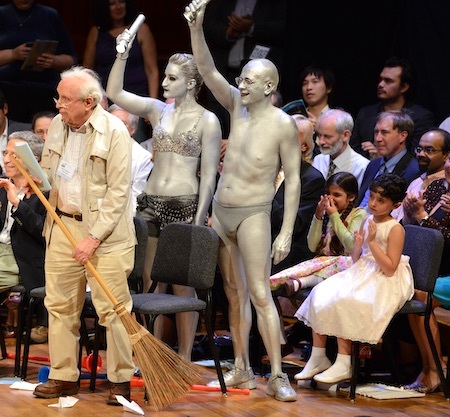
Roy and his broom, illuminated by human spotlights, at the 2012 ceremony.
Since then, Roy most years did double duty at the Ig Nobel Prize ceremony—physically presenting Ig Nobel prizes to some of the new winners, and yes, continuing to sweep paper planes. Roy also had roles (generally non-singing) in most of the Ig Nobel operas.
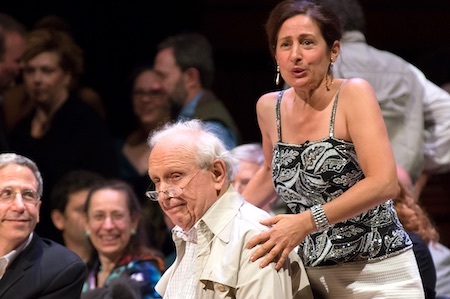
Roy with soprano Maria Ferrante, in the opera that was part of the 2012 ceremony. (You can watch video of that moment.)
We will miss Roy very much. And we will continue to treasure the now-famous broom that he entrusted to us (an action Roy took with glee many years ago, so that he, himself, would not have to bother to remember to bring it the ceremony every year).
Here are a few action photos of Roy at various Ig Nobel Prize ceremonies.
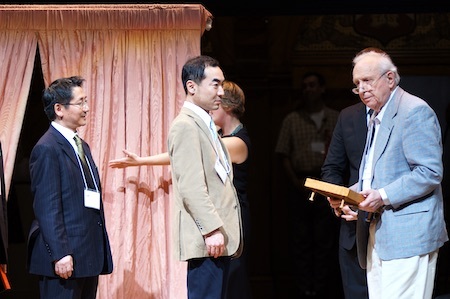
Roy presenting an Ig Nobel Prize to the inventors of the wasabi-fume fire alarm, in 2011.
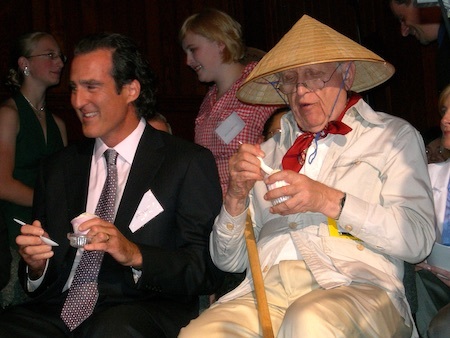
Roy and fellow Nobel laureate Craig Mello, at the 2007 ceremony, eating a specially-flavored ice cream created by Toscanini’s Ice Cream to honor the Ig Nobel Prize-winning chemist who invented a way to extract vanillin from cow dung.
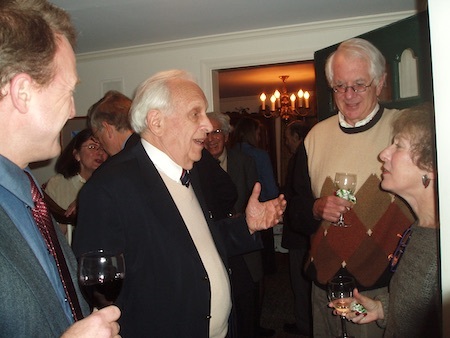
Roy at a house party given by friends in 2005, shortly after the announcement that Roy was being awarded a Nobel Prize in physics. The tall fellow on the right is Sheldon Glashow, with whom Roy shared an office for many years, patiently awaiting the era when not just one of them would have a Nobel Prize.

Roy presenting an Ig Nobel prize, at the 2006 ceremony, to the scientists who explained why when you bend a a strand of dried spaghetti it almost always breaks into more than two pieces.
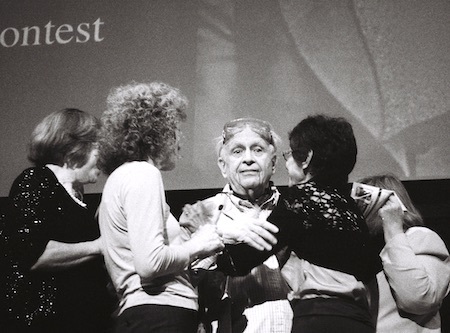
Roy at the 2006 Ig Nobel Prize ceremony at the moment when fifteen women collected him as their shared prize in that year’s Win-a-Date-With-a-Nobel-Laureate Contest.
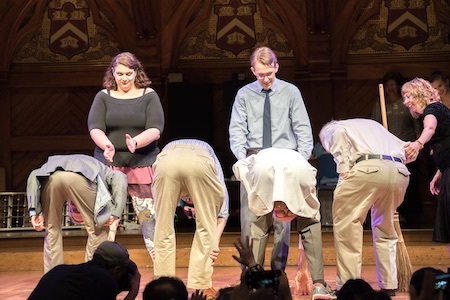
Left to right in the front row: Nobel laureates Eric Maskin, Rich Roberts, Dudley Herschbach, and Roy pay tribute to the scientists who investigated whether things look different when you bend over and view them between your legs. This was at the 2016 ceremony. Roy, maybe not quite as limber at age 92 as in his youth, still insisted on contributing his measure to the honors.
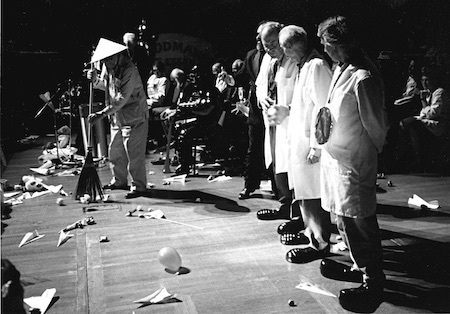
Roy sweeping paper airplanes at the 1998 ceremony. This is not as minor a task as some people assume. During the ceremony, so many paper airplanes accumulate on the stage that, without the good work of diligent sweepers, it would become impossible for anyone to walk safely.

The scourge of ‘Alphabetism’ (new paper from professor Zax)
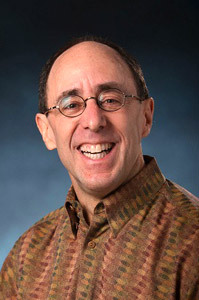 Professor Zax, who is (amongst other things) an anthroponomastician at the Department of Economics, University of Colorado at Boulder, US, presents (along with co-author Alexander Cauley) a new 48 page working paper which suggests that (males) who have a surname initial which occurs towards the end of the alphabet are more likely to end up academically and professionally undistinguished.
Professor Zax, who is (amongst other things) an anthroponomastician at the Department of Economics, University of Colorado at Boulder, US, presents (along with co-author Alexander Cauley) a new 48 page working paper which suggests that (males) who have a surname initial which occurs towards the end of the alphabet are more likely to end up academically and professionally undistinguished.
“Surnames with initials farther from the beginning of the alphabet were associated with less distinction and satisfaction in high school, lower educational attainment, more military service and less attractive first jobs.”
– say the team. The precise mechanisms, however, by which such effects might operate are perhaps suitable material for further anthroponomastical research.
See: Alphabetism: The Effects of Surname Initial and the Cost of Being Otherwise Undistinguished, University of Colorado Working Paper, Nov 2018.
Research research by Martin Gardiner

December 26, 2018
The Utility Fog of J. Storm Hall
Utility fog has a father, who wrote a report:
“Utility Fog: A Universal Physical Substance,” J. Storm Hall, Interdisciplinary Science and Engineering in the Era of Cyberspace, NASA Conference publication 10129, 1993, pp. 115-126. Hall, at Rutgers University, explains:
Active, polymorphic material (“Utility Fog”) can be designed as a conglomeration of 100-micron robotic cells (‘foglets’). Such robots could be built with the techniques of molecular nanotechnology….
The Fog acts as a continuous bridge between actual physical reality and virtual reality. The Fog is universal effector as well as a universal sensor. Any (real) object in the Fog environment can be manipulated with an extremely wide array of patterns of pressure, force, and support; measured; analyzed; weighed; cut; reassembled; or reduced to bacteria-sized pieces and sorted for recycling.
General Properties and Uses—As well as forming an extension of the senses and muscles of individual people, the Fog can act as a generalized infrastructure for society at large. Fog City need have no permanent buildings of concrete, no roads of asphalt, no cars, trucks, or busses. It can look like a park, or a forest, or if the population is sufficiently whimsical, ancient Rome one day and Emerald City the next.
(Thanks to Anthony Brooks for bringing this to our attention.)

December 25, 2018
A look back at the smile training machine
This German news report, from about 2009, looks at the Omron Smile Scan training machine, developed in Japan:
The manufacturer issued, in 2007, a press release heralding their then-new smile recognition technology.

December 24, 2018
The “Santa Claus Effect” – positive or negative? (two viewpoints)
Here’s the abstract of a 2017 study by Professor Brendan Kelly, Consultant Psychiatrist at Tallaght Hospital, School of Medicine, Trinity College, Dublin, Ireland.
Background: Christmas “is the season to be jolly” but, despite many recent studies of happiness and wellbeing, the population distribution of jollity is unknown.
Aims: To assess levels of jollity across Europe, hypothesising the existence of a “Santa Claus effect” whereby Mr. Claus, a long-established resident of Scandinavia, increases jollity through his social network.
Methods: Cross-sectional analysis of data from 37 966 participants in the European Society Survey (Round 7, 2014/2015) across 21 European countries.
Results: Jollity has independent associations with satisfaction with health and income, male gender, younger age, and country of residence. Each one-point increase in satisfaction with health (on a 5-point scale) corresponds to a 0.79-point increase in jollity (23-point scale); each one-point increase in satisfaction with income (4-point scale) corresponds to a 0.76-point increase in jollity. Switzerland is the jolliest country in Europe.
Conclusions: The jolliest European is likely to be a young Swiss male who is satisfied with his income and health. If there is a Santa Claus effect acting to increase jollity, it probably acts not just in Scandinavia but across Mr. Claus’s broad network of contacts and admirers in many countries.
See: Exploring and explaining the “Santa Claus effect”: cross-sectional study of jollity in 21 European countries, Journal of Mental Health, Volume 26, 2017 – Issue 6.
Where there is an opinion, however, there is always the possibility that there will be a counter-opinion. And in this case the possibility has turned into a documented reality. Because Professor Shaun O’Keefe of the Department of Geriatric Medicine, Galway University Hospitals, Galway, Ireland, protests – saying that :
“ I must protest his entirely one-sided portrait of Santa Claus and his comment on the ‘ubiquity of jollity at Christmas’. Santa may well be ‘‘very, very jolly’’ but this is on the back of his mistreatment and exploitation of elves and reindeers. Christmas generally leads to a decline in mood and in life satisfaction (Mutz, 2016; Sansone & Sansone, 2011). Furthermore, a quick Google search for jollity (5 September 2017) produces ‘‘about 1,270,000 results’’, many of them indeed referring to Christmas. However, the results total plummets to 438,000 when the search is repeated after excluding sites that also have the words ‘‘forced’’, ‘‘fake’’ or ‘‘false’’.
[…]
I suggest that the ‘‘Santa Claus’’ effect on true jollity is a negative one and that this is unsurprising if one is likely to be accosted by a disturbing character given to using the downright sinister ‘‘Ho! Ho! Ho!’’ as a greeting who plans to enter your home without permission in a most unorthodox way (Davis, 2012).”
See: Jollity and the “Santa Claus” effect: bah humbug? Journal of Mental Health, Volume 27, 2018 – Issue 2.
Research research by Martin Gardiner

Marc Abrahams's Blog
- Marc Abrahams's profile
- 14 followers




